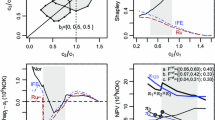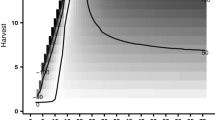Abstract
This study analyses a multispecies (cod, herring and sprat) partition function game among three asymmetric countries in the Baltic Sea. Through an empirical application, the study highlights the importance of dynamic multispecies models in coalition formation. We show that the grand coalition between the three countries can be stabilised when the most efficient country compensates the other countries. This solution is not feasible when using a single-species model for the cod population; thus, taking into account the multispecies nature of the Baltic Sea fisheries, the scope of cooperation increases compared with a single-species simulation. In contrast to the predominant conception, climate change may improve the likelihood of a binding agreement because with a lower cod biomass, countries will gain more from cooperation.


Similar content being viewed by others
Notes
However, as the problem in Poland likely lies in the incapability of enforcement and monitoring, side payments as such may not solve the dilemma unless they are directed to strengthening enforcement. Examining this issue further in the current paper would require enlarging the model to include the enforcement level, as done by, e.g., Kronbak and Lindroos (2006), who assessed how the level of enforcement affects coalition formation. However, this type of extension would make our model unreasonably complex and lead it partly away from its original objective. We gratefully acknowledge an anonymous reviewer for noting this issue.
Age class 2 consists of individuals aged 1–2 years, age group 3 consists of individuals aged 2–3 years, and so on.
Subscript c refers to cod throughout the study.
Subscripts h and s refer to herring and sprat, respectively, throughout the study.
The website for the supplementary data is: https://datacollection.jrc.ec.europa.eu/.
All prices and cost parameters are converted into 2013 euros and can be found in the “Appendix”.
In this paper, the approach used by, e.g., Rubio and Casino (2005) is followed, although some other studies rely on a dynamic membership game where the players can revise their membership decision periodically. According to Rubio and Ulph (2007), a dynamic membership game leads to an increasing number of countries in the agreement over time and results in higher welfare with a wide range of parameters; thus, it may be important to allow a revision in the membership over time. We acknowledge an anonymous reviewer for pointing this out.
We gratefully acknowledge an anonymous reviewer for pointing this out.
This is assumption is made to enable a comparison between the current and simulated fisheries. These current fishing mortalities represent each country’s actual fishing mortality and a share (based on the relative share of the catches) of the fishing mortalities of the remaining countries.
The objective function is now separated for each species; for example, for the cod fishery under a grand coalition, previous Eq. (14) is \(\textit{NPV}_{GC,c} =\max _{F_{i,c}} \sum _{t=1}^{50}{\sum _{i=1}^3{\frac{Q_{i,c}\left( t \right) -C_{i,c}\left( t\right) }{\left( {1+r_i}\right) ^{t-1}}}}\). The cost function of herring and sprat is split between the two fisheries.
References
Andersen JL, Nielsen M, Lindebo E (2009) Economic gains of liberalising access to fishing quotas within the European Union. Mar Policy 33(3):497–503
Aps R, Lassen H (2010) Recovery of depleted Baltic Sea fish stocks: a review. ICES J Mar Sci 67(9):1856–1860
Armstrong CW (1994) Cooperative solutions in a transboundary fishery: the Russian–Norwegian co-management of the Arcto-Norwegian cod stock. Mar Res Econ 9(4):329–351
Arnason R, Magnusson G, Agnarson S (2000a) The Norwegian spring-spawning herring fishery: a stylized game model. Mar Res Econ 15(4):293–319
Arnason R, Sandal LK, Steinshamn SI et al (2000b) Comparative evaluation of the cod and herring fisheries in Denmark, Iceland and Norway. Ekspressen Tryk og Kopicenter, Denmark
Barrett S (1994) Self-enforcing international environmental agreements. Oxf Econ Pap 46:878–894
Barrett S (2003) Environment and statecraft: the strategy of environmental treaty-making. Oxford University Press, Oxford
Björndal T, Lindroos M (2012) Cooperative and non-cooperative management of the northeast Atlantic cod fishery. J Bioecon 14(1):41–60
Blenckner T, Döring R, Ebeling M et al (2011) FishSTERN: a first attempt at an ecological-economic evaluation of fishery management scenarios in the Baltic Sea region. Swedish Environmental Protection Agency, Stockholm
Brandt US, Kronbak LG (2010) On the stability of fishery agreements under exogenous change: an example of agreements under climate change. Fish Res 101(1–2):11–19
Datta M, Mirman LJ (1999) Externalities, market power, and resource extraction. J Environ Econ Manag 37(3):233–255
Diekert FK, Hjermann DØ, Nævdal E et al (2010) Non-cooperative exploitation of multi-cohort fisheries—the role of gear selectivity in the north-east Arctic cod fishery. Resour Energ Econ 32(1):78–92
Duarte CC, Brasao A, Pintassilgo P (2000) Management of the Northern Atlantic bluefin tuna: an application of C-games. Mar Res Econ 15(1):21–36
Edwards SF, Link JS, Rountree BP (2004) Portfolio management of wild fish stocks. Ecol Econ 49(3):317–329
European Commission (2013) The 2013 annual economic report on the EU fishing fleet. Publications office of the European Union, Luxembourg
European Union (2013) Regulation (EU) No. 1380/2013 of the European Parliament and of the Council on the Common Fisheries policy, amending Council Regulations (EC) No. 1954/2003 and (EC) No. 1224/2009 and repealing Council Regulations (EC) No. 2371/2002 and (EC) No. 639/2004 and Council Decision 2004/585/EC
Eyckmans J, Finus M (2009) An almost ideal sharing scheme for coalition games with externalities. Economics, Stirling Discussion Paper (2009–2010)
Finus M (2000) Game theory and international environmental co-operation: a survey with an application to the Kyoto-protocol. Fondazione Eni Enrico Mattei, Milan
Finus M, Schneider R, Pintassilgo P (2011) The incentive structure of impure public good provision—the case of international fisheries. Discussion papers 1103. Department of Economics, Exeter, University
Fischer RD, Mirman LJ (1996) The compleat fish wars: biological and dynamic interactions. J Environ Econ Manag 30(1):34–42
Florio M, Finzi U, Genco M et al (2008) Guide to cost-benefit analysis of investment projects. Evaluation Unit, DG Regional Policy, European Commission, Brussels
Fuentes-Albero C, Rubio SJ (2010) Can international environmental cooperation be bought? Eur J Oper Res 202(1):255–264
Gollier C, Koundouri P, Pantelidis T (2008) Declining discount rates: economic justifications and implications for long-run policy. Econ Policy 23(56):757–795
Gordon HS (1954) The economic theory of a common-property resource: the fishery. J Polit Econ 62(2):124–142
Heikinheimo O (2011) Interactions between cod, herring and sprat in the changing environment of the Baltic Sea: a dynamic model analysis. Ecol Model 222(10):1731–1742
Hilborn R, Walters CJ (1992) Quantitative fisheries stock assessment: choice, dynamics and uncertainty. Chapman and Hall, New York
ICES (2005) Report of the study group on multispecies assessment in the Baltic (SGMAB). Technical report International council for the exploration of the sea (ICES), Riga
ICES (2013) Report of the ICES Advisory Committee 2013. Technical report, International council for the exploration of the sea (ICES), Copenhagen
ICES (2014) Report of the Baltic fisheries assessment working group (WGBFAS). Technical report, International council for the exploration of the sea (ICES), Copenhagen
Kaitala V, Lindroos M (1998) Sharing the benefits of cooperation in high seas fisheries: a characteristic-function game approach. Nat Res Model 11(4):275–299
Kronbak LG, Lindroos M (2006) An enforcement-coalition model: fishermen and authorities forming coalitions. Environ Res Econ 35(3):169–194
Kronbak LG, Lindroos M (2007) Sharing rules and stability in coalition games with externalities. Mar Res Econ 22(2):137–154
Kronbak LG, Lindroos M (2011) On species preservation and non-cooperative exploiters. Strateg Behav Environ 1(1):49–70
Kulmala S, Levontin P, Lindroos M et al (2013) Atlantic salmon fishery in the Baltic Sea—a case of trivial cooperation? Strateg Behav Environ 3(1–2):121–147
Kulmala S, Peltomäki H, Lindroos M et al (2007) Individual transferable quotas in the Baltic Sea herring fishery: a socio-bioeconomic analysis. Fish Res 84(3):368–377
Li E (1998) Cooperative high-seas straddling stock agreement as a characteristic function game. Mar Res Econ 13(4):247–258
Meier HEM (2006) Baltic Sea climate in the late twenty-first century: a dynamical downscaling approach using two global models and two emission scenarios. Clim Dyn 27(1):39–68
Neumann T (2010) Climate-change effects on the Baltic Sea ecosystem: a model study. J Mar Syst 81(3):213–224
ORCA EU (2008) A report on IUU fishing of Baltic Sea cod. In: Sporrong N (ed) Report commissioned from ORCA-EU. The Fisheries Secretariat, Bromma
Oxford Economics (2010) Oil price outlook to 2030. Technical report, Oxford, UK
Pham DH, Folmer H (2006) International fisheries agreements: the feasibility and impacts of partial cooperation. In: Aronsson T, Axelsson R, Brännlund R (eds) The theory and practice of environmental and resource economics: essays in honour of K.-G. Löfgren ch. 8. Edward Elgar, Cheltenham, pp 146–171
Pintassilgo P (2003) A coalition approach to the management of high seas fisheries in the presence of externalities. Nat Res Model 16(2):175–179
Pintassilgo P, Finus M, Lindroos M et al (2010) Stability and success of regional fisheries management organizations. Environ Res Econ 46(3):377–402
Pintassilgo P, Lindroos M (2008) Coalition formation in straddling stock fisheries: a partition function approach. Int Game Theory Rev 10(3):303–317
Rockwood LL (2006) Introduction to population ecology. Blackwell Publishing, Oxford
Rubio SJ, Casino B (2005) Self-enforcing international environmental agreements with a stock pollutant. Span Econ Rev 7(2):89–109
Rubio SJ, Ulph A (2007) An infinite-horizon model of dynamic membership of international environmental agreements. J Environ Econ Manag 54(3):296–310
Scott A (1955) The fishery: the objectives of sole ownership. J Polit Econ 63(2):116–124
Sumaila UR (1997) Strategic dynamic interaction: the case of Barents Sea fisheries. Mar Res Econ 12(2):77–94
Sumaila UR, Walters C (2005) Intergenerational discounting: a new intuitive approach. Ecol Econ 52(2):135–142
van Hoof L (2013) Design or pragmatic evolution: applying ITQs in EU fisheries management. ICES J Mar Sci 70(2):462–470
Wang W, Ewald C (2010) A stochastic differential fishery game for a two species fish population with ecological interaction. J Econ Dyn Control 34(5):844–857
Weikard H-P (2009) Cartel stability under an optimal sharing rule. Manch Sch 77(5):575–593
Yi S, Shin H (2000) Endogenous formation of research coalitions with spillovers. Int J Ind Organ 18(2):229–256
Acknowledgments
We thank the three anonymous reviewers for their constructive comments, which helped us to improve the manuscript. This paper is a deliverable of the Nordic Centre for Research on Marine Ecosystems and Resources under Climate Change (NorMER), which is funded by the Norden Top-level Research Initiative sub-programme ‘Effect Studies and Adaptation to Climate Change.
Conflict of interest
The authors declare that they have no conflict of interest.
Author information
Authors and Affiliations
Corresponding author
Rights and permissions
About this article
Cite this article
Nieminen, E., Kronbak, L.G. & Lindroos, M. International Agreements in the Multispecies Baltic Sea Fisheries. Environ Resource Econ 65, 109–134 (2016). https://doi.org/10.1007/s10640-015-9933-x
Accepted:
Published:
Issue Date:
DOI: https://doi.org/10.1007/s10640-015-9933-x




